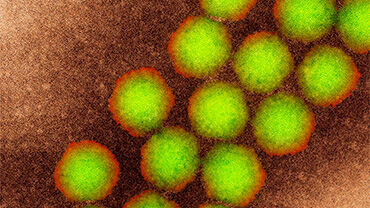Communicable disease threats report

Poliomyelitis
Poliomyelitis, also known as polio or infantile paralysis, is a vaccine-preventable systemic viral infection affecting the motor neurons of the central nervous system (CNS).
Poliomyelitis, also known as polio or infantile paralysis, is a vaccine-preventable systemic viral infection affecting the motor neurons of the central nervous system (CNS). Historically, it has been a major cause of mortality, acute paralysis and lifelong disabilities but large scale immunisation programmes have eliminated polio from most areas of the world.
Sustainable Development Goals (SDGs)
- Goal 3: Good Health and Well-being – Poliomyelitis is a disease that directly impacts the health and well-being of individuals, particularly children. By eliminating polio through immunization programs, countries can contribute to achieving this SDG.
- Goal 4: Quality Education – Polio can cause lifelong disabilities, which can hinder a child’s ability to access quality education. By preventing polio, countries can ensure that children have the opportunity to receive a proper education.
- Goal 10: Reduced Inequalities – Polio has historically affected marginalized communities and populations with limited access to healthcare. By focusing on immunization efforts and reaching these communities, countries can work towards reducing inequalities in health.
- Goal 17: Partnerships for the Goals – The global effort to eliminate polio requires collaboration and partnerships between governments, international organizations, and civil society. By working together, countries can strengthen their immunization programs and accelerate progress towards the SDGs.
Read more
SDGs, Targets, and Indicators
-
SDG 3: Good Health and Well-being
- Target 3.2: By 2030, end preventable deaths of newborns and children under 5 years of age, with all countries aiming to reduce neonatal mortality to at least as low as 12 per 1,000 live births and under-5 mortality to at least as low as 25 per 1,000 live births.
- Indicator: Neonatal mortality rate and under-5 mortality rate.
-
SDG 4: Quality Education
- Target 4.7: By 2030, ensure that all learners acquire the knowledge and skills needed to promote sustainable development, including, among others, through education for sustainable development and sustainable lifestyles, human rights, gender equality, promotion of a culture of peace and non-violence, global citizenship and appreciation of cultural diversity and of culture’s contribution to sustainable development.
- Indicator: Proportion of schools with access to adapted infrastructure and materials for students with disabilities.
Table: SDGs, Targets, and Indicators
| SDGs | Targets | Indicators |
|---|---|---|
| SDG 3: Good Health and Well-being | Target 3.2: By 2030, end preventable deaths of newborns and children under 5 years of age, with all countries aiming to reduce neonatal mortality to at least as low as 12 per 1,000 live births and under-5 mortality to at least as low as 25 per 1,000 live births. | Neonatal mortality rate and under-5 mortality rate. |
| SDG 4: Quality Education | Target 4.7: By 2030, ensure that all learners acquire the knowledge and skills needed to promote sustainable development, including, among others, through education for sustainable development and sustainable lifestyles, human rights, gender equality, promotion of a culture of peace and non-violence, global citizenship and appreciation of cultural diversity and of culture’s contribution to sustainable development. | Proportion of schools with access to adapted infrastructure and materials for students with disabilities. |
Source: ecdc.europa.eu








